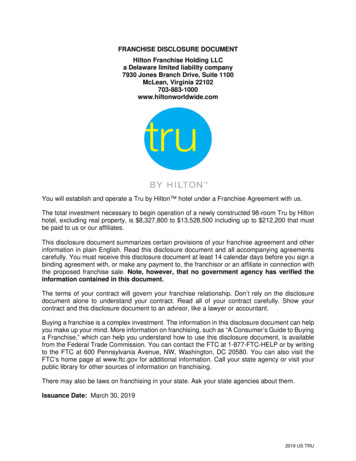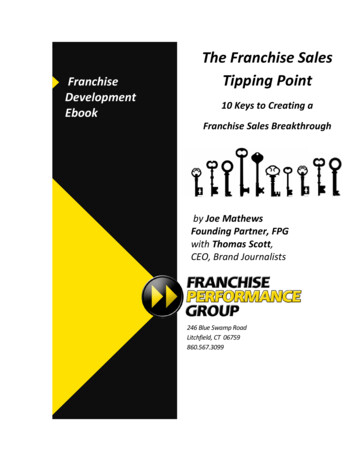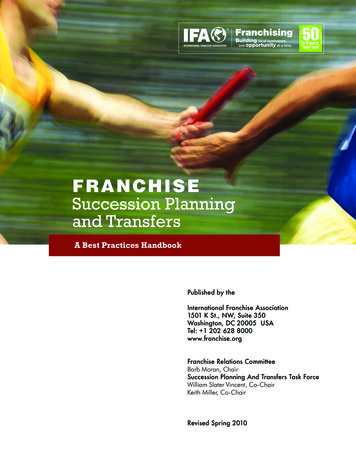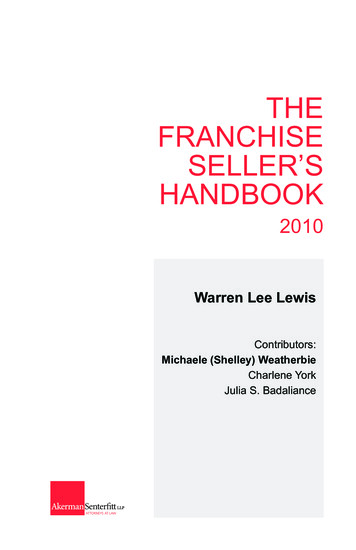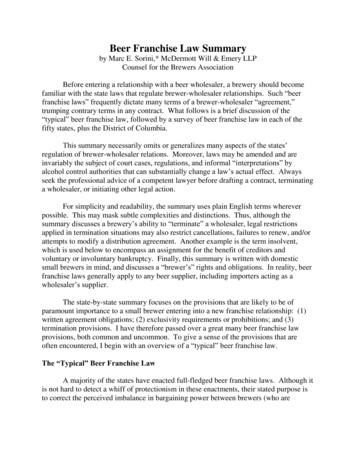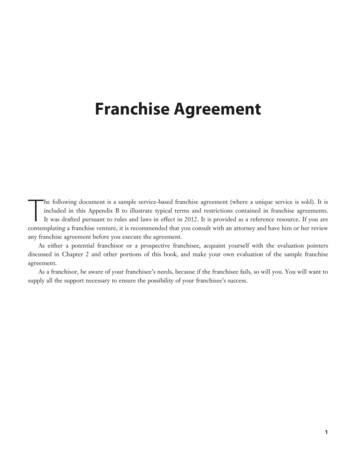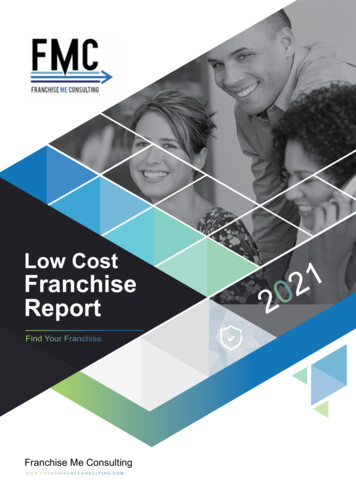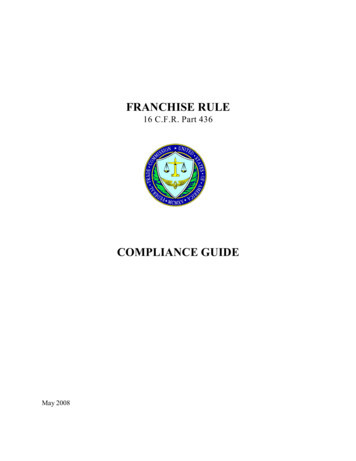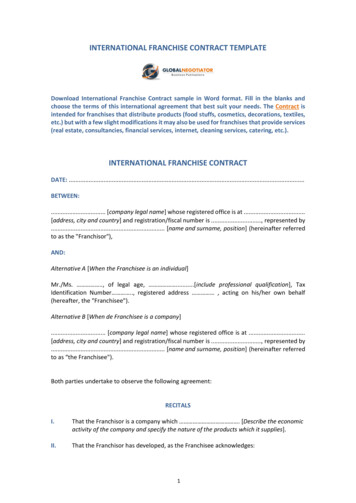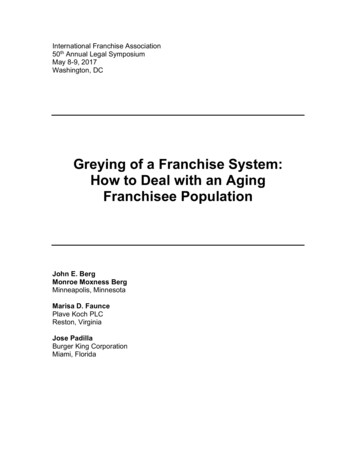
Transcription
International Franchise Association50th Annual Legal SymposiumMay 8-9, 2017Washington, DCGreying of a Franchise System:How to Deal with an AgingFranchisee PopulationJohn E. BergMonroe Moxness BergMinneapolis, MinnesotaMarisa D. FauncePlave Koch PLCReston, VirginiaJose PadillaBurger King CorporationMiami, Florida
TABLE OF CONTENTSI.Introduction . 1II.Exit Strategy / Succession Planning . 1A. Choosing the Right Structure Prior to Death: The Value of SuccessionTrusts to Franchisors and Franchisees . 2B. Succession Trusts: Avoiding Probate and Protecting Assets . 3C. Exit Planning: A Franchisee’s To-Do List . 6D. Transferring to Insiders: Family Members, Management or Employees. 9III.The Franchisor’s Role in the Transfer of a Franchise . 11A. Franchise Agreement Provisions . 11B. State Regulation of Transfers . 13IV.The Transfer Process . 20A. Transfer Policies and Guidelines . 20B. Internal Steps To Review Transfer Applications . 21C. Challenges in the Transfer Process. 26V.Conclusion . 26EXHIBITSA - Sample Notice of Change of Ownership Interests in Franchisee (Death orDisability)B - Sample Notice of Change of Ownership Interests in FranchiseeC – Sample Letter re Transfer RequestD - Sample Assignment Agreement for Transfers for Convenience of OwnershipE – Sample Consent to Transfer of Ownership Interests to a Trusti
I.IntroductionAccording to the International Franchise Association, more than 90% of allbusinesses in the United States are family owned and two-thirds of the country’sGross Domestic Product is produced by family-owned businesses. In the last 20years, more than 80% of net new jobs created in the US were created by familyowned businesses. However, the statistics demonstrate that almost 70% of thesebusinesses, including family-owned franchises, will not survive to the secondgeneration after the loss of the original owner, and of those that do, only 12% willsucceed to the third generation.1 The reasons for these statistics vary from asudden illness or death of the original owner, the desire to retire and shut downthe business, an inability to identify a successor, and lack of funds to develop aviable estate plan. Although many franchised business owners would like to seethe business stay within their family after their retirement or death, the 70% rateindicates that succession planning is not taking place. It is clearly in the bestinterest of both the franchisor and the franchisee to develop a succession plan toensure the continuation and future health of the franchised business and theoverall franchise system. In this paper we evaluate various options for afranchisee’s succession plan, as well as various transfer policies and proceduresthat franchisors should have in place for their franchise systems.II.Exit Strategy / Succession PlanningFranchisees and their owners spend a great deal of time and energyevaluating franchise opportunities and developing business plans for thefranchised businesses that they purchase. Unfortunately, business planningoften stops after they purchase the franchise, and their focus becomes fixed ongrowing and tending the business rather than on preparing to part with it. Afterall, what percentage of people eagerly rush to put a will in place? How manyworry about an advanced care directive or life insurance? To postpone suchconsiderations is a natural human tendency.Among those franchised business owners who do think about exitplanning, too many make the mistake of thinking that the time to develop an exitstrategy or succession plan is when they are ready to sell the business, transfertheir ownership interest, or retire. Unfortunately, once they reach thesemilestones, most of the value that could be generated by developing andimplementing a productive succession plan has already been lost. Thesebusiness owners wrongly assume that they can easily sell the franchisedbusiness to a third party, transfer their ownership interest to a family member orsuccessor, or wind down the business at retirement without understanding therestrictions set forth in their franchise agreements.Likewise, succession planning is of vital importance to franchisors whowant to maintain their competitive edge, keep franchised businesses open at1International Franchise Association, Succession Planning & Transfers Handbook, p. 1 (2010).1
their existing locations, and ensure that trained operators are available toproperly implement system standards and operating procedures. The abovestatistic that 70% of franchised businesses will not succeed to the secondgeneration following the retirement, death or disability of the original ownershould cause every franchisor to take notice and implement succession planningguidelines for their franchised systems. Ultimately, succession and exit strategyplanning requires input from the franchisees and their franchisor, and it must bedesigned in the way that takes into account the unique aspects of the franchisedbusiness model.A.Choosing the Right Structure Prior to Death: The Value ofSuccession Trusts to Franchisors and Franchisees1.ProbateAn operator of a franchised business may die intestate (i.e., without a will)or with a will. In either case, in most states an individually-owned franchisedbusiness will end up in probate at the owner’s death. Probate is the legal processof transferring title to assets following the death of the owner of the assets undereither the owner’s estate plan or the state’s intestacy laws. Probate can be anincredibly time-consuming and costly process. Not only is this a burden on thefranchised business owner’s surviving family, but it can also be a drain on thefranchisor’s resources, as the franchisor is in effect partnered with the probatecourt during the process that can last several years.Probate proceedings can interfere with the smooth operations of thefranchisee’s business. By placing decision-making authority in the hands of aprobate court, these proceedings can potentially lead to decisions that aredetrimental to the franchisor and the franchisee.Another downside of probate is that it is public — anyone who isinterested can find out what assets are owned and how they are being distributedafter the owner’s death. The public nature of probate can also draw unwantedattention from disgruntled family members who may challenge the disposition ofthe owner’s assets, as well as from other unscrupulous parties. Probate is aninvitation for such individuals to object, which then raises the level of courtsupervision and increases costs.A great example of just how much turmoil probate proceedings canintroduce to the running of a business is the legal battle that erupted following the2006 death of Robert H. Brooks, owner of the Atlanta-based restaurant chainHooters . In his will, Brooks left 30% of his estate to each of his two childrenfrom his first marriage (one of whom, Coby Booker, became the new CEO).Brooks’ second wife, Tami, was to have received 1 million per year for 20years; but she rejected the offer and went to court in search of a larger portionof her late husband’s estate. She invoked South Carolina’s "elective share"law, according to which widows and widowers can claim one-third of their dead2
spouses' estates, instead of any bequest that they may have been left in thewill. It took three years of legal wrangling and public acrimony for Booker andTami to settle for an undisclosed sum. To raise it, Booker was forced to sellHooters to a private equity firm, and soon after he was let go.B.Succession Trusts: Avoiding Probate and Protecting AssetsThe most effective tool for a franchisor and its franchisees to avoidprobate and ensure the continuing success of the franchised business during theprocess of transition is a succession trust.A trust is an estate planning tool created by an individual to manage his orher assets prior to death and to specify how the assets are to be distributed afterdeath. The individual creating the trust, called a “trustor,” or “grantor,” transfersownership of property and assets during their lifetime into the trust for the benefitof his heirs or other named beneficiaries.There are two types of trusts, revocable and irrevocable:1.A revocable trust agreement provides a mechanism forowning and managing assets both during the owner’s life and after death. Byestablishing a trust and transferring title of his or her assets to the trust, thebusiness owner enables an appointed trustee to dispose of the assets at theowner’s death in the manner set forth in the trust document without a need for aprobate proceeding. As the name implies, a revocable trust can be changed,amended, modified or revoked at the trustor’s discretion – so while it helps thebusiness owner avoid probate, it still leaves the assets potentially available forcreditor claims. A revocable trust also allows the grantor to provide formanagement succession of his assets in the event of incapacitation or disability.Because the trustor maintains control over all of the assets in a revocable livingtrust, such a trust does not avoid estate taxes, which become due when theassets are transferred to his heirs or beneficiaries after his death.2.An irrevocable trust agreement generally cannot bechanged, amended, modified or revoked even with a court order, thus offeringcoveted asset protection to the grantor. Since the assets in the irrevocable trustno longer belong to the grantor, they are generally protected from creditors orfrom other claimants (unlike the assets in the revocable trust). In addition, theassets are protected from Medicaid claims and divorcing spouses. The term“irrevocable” generally implies that the trust cannot be changed under anycircumstances; an exception would be a special power of appointment in the trustdocument that may allow the grantor the freedom to modify the namedbeneficiaries at his discretion without affecting the benefits of the irrevocabletrust. From a franchisor’s point of view, however, such changes in beneficiariesshould be of little concern; the focus, instead, should be on appointing a reliabletrustee.3
3.Why Franchisors should Embrace Succession TrustsDespite the advantages of a trust structure to both franchisees andfranchisors, many franchise systems do not currently allow for trust ownership offranchised interests (or if they do allow for trust ownership, it comes at the cost ofhaving to satisfy potentially onerous conditions). For franchise systems that havenot yet considered the advantages of allowing trust-owned franchised interests,the following benefits should be considered: Provides business continuity planning. One of the most significantblows a franchised business can receive is when an owner/operator diesor becomes incapacitated unexpectedly. Such an event commonly leadsto confusion and uncertainty over who will take the reins of the business.A business succession trust typically provides for this possibility andcreates a management structure that can immediately run the business. Addresses ownership transition issues. If the business owner intends totransfer the business to a family member, an insider in the business, or evento a known third party, the business transition trust can implement this plan.Without such a plan, there often is chaos about when and how the businessis transferred. Minimizes royalty payment disruption. Since the primary goal of abusiness succession trust is to ensure the orderly and efficient transition ofthe business, the odds of the business continuing to operate increase,which ensures that the business is able to continue making its royaltypayments to the franchisor. Franchisors dealing with the death orincapacity of a franchisee who did not plan for the event understand thesignificant and immediate negative financial impact all too well. Helps maintain system standards. One of the obvious consequences ofpoor succession planning is the rapid deterioration of the franchisedbusiness operation in the event of the franchisee’s death or disability. Thefinancial stress put on a poorly prepared business quickly evinces itself indeclining maintenance, capital expenditures, rapid turnover of seniormanagement and missed remodeling deadlines. Encouraging franchiseesto use business succession trusts can prevent this situation: a soundsuccession trust should clearly lay out the guidelines, benchmarks andmetrics needed to maintain consistency in operations, employee continuityas well as the overall franchise system standards. Minimizes liquidity problems. Poor planning by franchisees generallyresults in unnecessary tax consequences at the owner’s death. This canput the family in financial crisis and either require a fire sale or thewithdrawal of funds that are necessary to the continued operation of thefranchised business. The use of a business succession trust, coupled with4
the appropriate estate plan, can provide much needed estate tax planningat death. Trust planning can also facilitate lifetime wealth transfers to theowner’s family that can further minimize potential estate taxes. Federaland state estate tax rates vary but under current laws can exceed 50%. Becomes franchisee recruiting tool. Franchise systems that areproactive in not only allowing, but encouraging, franchisee succession andexit planning are viewed favorably by prospective franchisees. Franchisorswho are able to offer these succession and exit planning tools within thesystem have an advantage over systems that do not. Franchisees areraising this issue today in the recruitment process and this issue will onlybecome more prevalent in the future. Responsive to franchisee concerns. Succession and exit planning arehot topics on franchisee surveys in many franchise systems. Takingproactive steps to help address the franchisees’ concerns shows not onlythat the franchisor is listening to these concerns, but that he/she is willingto do something about it. Allows franchisor to control the process. In systems that do not allowtrust ownership, many franchisees are transferring their interests to trustsand not disclosing it to the franchisor. This prevents the franchisor fromhaving any input on the types of trusts allowed or the overall transferprocess. Allowing trust ownership provides the franchisor with the ability todictate what types of trusts will be permitted and the process thatfranchisees need to follow to transfer interests to trusts. Provides system efficiency. By proactively defining the types of trusts thata franchisor will permit in the franchise system and the related transferprocess, the franchisor can avoid having to review, comment, and negotiateeach franchisee’s situation independently. Having rules and standards inplace significantly streamlines the trust compliance process and minimizesfranchisor resources needed to deal with this issue.Franchisors have not traditionally been receptive to trust ownership offranchisee businesses. Whether this is due to a lack of familiarity with estateplanning issues or a fear of the unknown, franchisors are encouraged to reviewthis policy and reconsider their position due to the overwhelming benefits for bothfranchisors and franchisees. What they may discover is that good planning forfranchisees is also good planning for them and for the franchise system, and thatbeing flexible and open to succession trusts will reap financial rewards in thefuture.4.Next Steps for FranchisorsFranchisors may need to revise their existing franchisee recruitment andtransfer policies to operate with trusts. Traditionally, franchisors have expressed5
concern about their franchisees transferring assets to recipients who are beyondthe franchisors’ reach. If this is a concern, then choosing a revocable trust wouldprovide an acceptable solution for managing this risk. In the case of anirrevocable trust, the franchisor should consider having the trust guarantee thefranchise obligations and restrict distributions from the trust, while also takingcare to appoint an independent-minded, reliable trustee. Since the trust would bemanaging the assets in accordance with the terms of the franchise agreement,the franchisor’s right of first refusal and other rights would continue to be ineffect.Franchisors are discouraged from getting too involved in the selection ofbeneficiaries or in beneficiary changes. Once the provisions outlined above are inplace, there is no need for additional restrictions, and the franchisor will not haveto devote time to closely monitoring the trust’s activities.C.Exit Planning: A Franchisee’s To-Do ListA franchised business owner should begin the exit-planning process atleast three years before the projected exit date. To ensure that the plan helpsbusiness owners achieve their long-range objectives, the process typicallyinvolves most, if not all, of the stages outlined below. We cannot emphasizeenough that what follows are very general outlines, and the specific solutions willvary greatly in each individual succession plan, depending on the franchisee’sspecific circumstances.1.Establishing Owner ObjectivesThe starting point is identifying the business owner’s objectives.Determining his/her objectives regarding the exit from his/her business generallycan be accomplished by answering these questions: How much cash do you need when you exit to support the lifestyle youdesire? (Do you want to be cashed out when you leave the business or areyou willing to receive the purchase price over time?) When do you want to leave the business? (Or, how much longer are youwilling to remain active in the business?) To whom do you want to sell / transfer the business? (To a child? Whichone? To a key employee? Co-owner? Or perhaps to an outside party whocan pay top dollar?)2.Establishing Business ValueWhile the previous phase establishes what the business owner wants orneeds in order to leave their business on their terms, this phase determines whatthey have now. In other words, what is the business worth today? Determiningthe current value of the business tells us whether there is sufficient value in the6
business to support the business owner’s post-exit income needs. Most businessvalues are discussed in terms of a multiple of EBITDA, and other factorsimpacting valuations may include the remaining term on agreements/leases, thecondition of assets, trade-area prospects, etc. Sellers can work with brokers,valuation advisors or franchisors to determine the current value. If the currentvalue falls short of this objective, part of the exit plan will be to increase the valueof the business to a minimum acceptable level or, if that is not feasible, torecalibrate the owner’s expectations. This valuation issue also must be viewed incontext of the owner’s likely successor for the business. If the exit plan involvestransferring the business to family members or key employees, a lower businessvaluation may be preferable. On the other hand, a sale of the business to a thirdparty may require the absolute highest possible valuation for the business.3.Building Value and Cash FlowA critical part of an exit plan is working with the business owner’saccounting, legal and tax advisors to develop and enhance the key value driversfor the business. These value drivers may include: an effective managementteam (particularly crucial in the event of the owner’s sudden death or disability),efficient operating systems, an established and diverse customer base, a realisticgrowth strategy, effective financial controls, a stable and increasing cash flow,and a tax-efficient business structure. Working on these value drivers now willhelp ensure that the business is best positioned to fulfill the business owner’s exitobjectives.4.Creating Ownership/Management SuccessionHaving assembled his team of advisors, the franchisee “must identifythose qualities that his successor must possess in order to successfully run andoperate the franchise. Many franchisors require certain qualifications of asuccessor to the existing franchisee. Depending upon the type of franchise,these may include some specific and highly technical skills. Such qualities wouldbe assessed by the franchisee, his advisors, and the franchisor as part of thesuccession plan.”2 Working closely with the franchisor throughout this process iscrucial to reaching consent on the choice of the successor.Once the successor has been picked, “the franchisee must train thesuccessor by transferring his knowledge to the successor gradually over time.Depending upon the franchise, the owner will need a transition period of one tothree years to adequately train his successor.”3“Initially the successor will shadow and just watch the owner. Graduallythe owner will delegate more and more responsibilities to his successor so thathe can effectively train the successor. Also, this transition period allows for notonly the other employees of the franchise but also for the franchisee's customers,23International Franchise Association, Succession Planning & Transfers Handbook, p. 3 (2010).Id., p. 4.7
suppliers, and vendors to develop confidence in the successor as well. The endresult is that all parties come to identify the franchise with the successor asopposed to the original owner.”45.Selling to a Third Party for Top DollarThis option involves two primary objectives. The first objective is to find abuyer willing to pay absolute top dollar for the business through a controlledauction, a negotiated sale or other method. The second is to ensure that the saleis structured to maximize the after-tax proceeds to the business owners. The firstplace to look for potential buyers is within the system: sellers should definitelyconsider existing franchisees but ensure that they are approved to grow.Generally, owners are attracted to a third party sale (rather than a sale toinsiders - family members, co-owners or employees) for one or more of thefollowing reasons: When the market is favorable and strategic buyers are active in themarketplace, a sale to a third party can yield more cash. A sale to a third party usually is less risky than one to insiders. Sellers get their money faster than in a transfer to insiders. Insiders don’t have what it takes (usually cash and sometimes desire) tobuy the company.Owners who opt to sell to a third party need to assemble a deal team byinterviewing prospective advisors. Depending on the size of the business, atransaction intermediary may be an investment banker or a business broker. Theteam may also include an attorney skilled in transaction work and an accountantskilled in tax minimization techniques. The deal team members will use theirexpertise to help create a plan that:4 Minimizes the tax consequence of the deal; Takes into account the owner’s willingness (or unwillingness) to remainactive in the business once the deal closes; Determines whether the transaction will best be conducted as a controlledauction or negotiation; Specifies what kind of payment the owner will accept; andId.8
Last, but not least, includes a strategy that allows the owner to focus onthe business’s profitability while the transaction occurs.Tip: Don’t leave a bunch of “minor” deal points to the last minute, and makesure contracts are clear (What will be pro-rated? Who gets that rebate? Whowill pay the transfer fees?).D.Transferring to Insiders: Family Members, Management orEmployeesIf the business owner’s objective is to sell or transfer the business toinsiders, the exit plan will be structured very differently than a plan contemplatinga sale to a third party. It is advisable to reveal this intention to the franchisor earlyon or simply to be prepared for the franchisor not to accept the proposed deal. Ingeneral, a sale to insiders does not end with a closing. It only ends when thebusiness owner gets paid.The potential benefits to this type of transfer include: Keeping the business in the family or extending the owner’s legacy througha hand-picked management group; Motivating, retaining and rewarding key employees; Reaping more after-tax money than a third-party transfer; Retaining control until all, or most, of the purchase price is received; Remaining active in the business while gradually reducing day-to-dayresponsibilities; Gaining time to build up personal assets (via distributions of cash) beforethe exit.There are, however, significant risks associated with this type of transfer,and they require careful mitigation:1.Insiders have no money. What is needed is a transferstrategy that puts money in their pockets as they increase the value of thebusiness. Years in advance of the transfer, the owner will have to work steadilyand effectively to build cash flow (the source for all cash out) through theinstallation of value drivers and through careful planning to minimize taxation.2.Cash flow can be taxed twice. Poorly planned insider salescan result in excess income taxes. Through effective tax planning, however,much of this tax burden can be legally avoided. The owner and advisors(including a certified business appraiser) should use a modest, but defensible9
valuation for the business. Because a lower value is used for the purchase price,the size of the tax bite is correspondingly reduced. The difference between whatthe owner will receive from the sale of the business, at a lower price, and whatthe owner wants to be paid after leaving the business is “made good” through anumber of different techniques to extract cash from the company after theowner’s exit.3.Successor’s management/ownership skills are untested.This risk calls for a written plan to systematically transition management andownership responsibilities to the successor--beginning today. The transitionperiod, during which the owner tests both his assumptions and his successors’skills, usually takes several years to complete.4.The owner loses control before being cashed out. This isonly true if the owner (and his advisors) fails to implement a transfer strategydesigned to accomplish the opposite: to be cashed out before losing control. Insuch a plan, the owner keeps control, in part through a well-designed andincremental sale of the company over time, based upon improving company cashflow over time.Employee Stock Ownership Plans, which involve transferring ownership ofthe company both to family members and to employees, cannot be used on theirown to transfer ownership wholly to family members, but they can be used incombination with other methods of transfer - such as gifting or recapitalization to keep majority ownership in a family.One method for keeping good employees interested in growing thebusiness is “key man” insurance. This is a policy in the name of the employee,where the company pays the premium and the employee accrues the cash valueof the policy.5.Wealth preservation planning. A comprehensive exit planmust contain the proactive design and implementation of wealth preservationstrategies before ownership of the business is transferred. An effective wealthpreservation plan will protect the value of the business currently, as well as in theevent of the owner’s unexpected death or permanent disability. Wealthpreservation also encompasses the owner’s plan for transferring wealth (either inthe form of the business itself or exit proceeds) to future generations.10
III.The Franchisor’s Role in the Transfer of a FranchiseA.Franchise Agreement Provisions1.A Franchisor’s Right to Approve TransfersFranchisors go great lengths to review franchise applications for the saleof new franchises to “prospective franchisees”. 5 Background checks, search ofthe Office of Foreign Asset Control terrorist watch lists, personality tests, financialstatements and operational criteria are routinely evaluated in the applicationprocess as franchisors try to verify whether the applicant will be a good fit for thebrand. Likewise, transfer applicants are screened with this same attention todetail to ensure that the transferee can step into the transferor’s businessoperations without harming the customer experience and the brand.Transfers come in many shapes and sizes as existing franchisees bring innew investors, release former owners, form new business entities, and engage insuccession planning. A franchise agreement, therefore, must be drafted tobroadly address each potential transfer. Typically, the franchise agreement willfirst demonstrate the franchisor’s interest in selecting a particular franchisee andthen will contain a broad definition of transactions that will qualify as transfersthat will trigger a need to obtain the consent of the franchisor. For example:You understand and acknowledge that the rights andduties set forth in this Agreement are personal to youand that we have entered into this Agreement inreliance on your and your owners’ business skill,financial capacity, personal character, experience anddemonstrated or purported ability to develop andoperate high quality business operations. Accordingly,neither you, your owners, nor any immediate orremote successor to any part of your interest in thisAgreement shall sell, divide, assign, transfer, convey,give away, pledge, mortgage, transfer in trust, divorceor operation of law or by other means, or otherwiseenc
2006 death of Robert H. Brooks, owner of the Atlanta-based restaurant chain Hooters . In his will, Brooks left 30% of his estate to each of his two children from his first marriage (one of whom, Coby Booker, became the new CEO). Brooks' second wife, Tami, was to have received 1 million per year for 20

